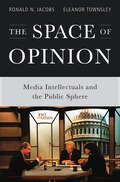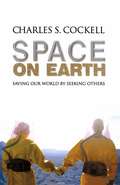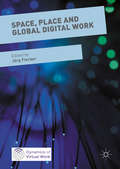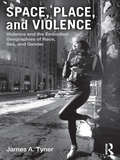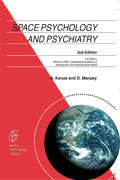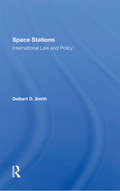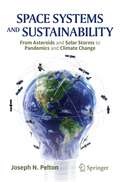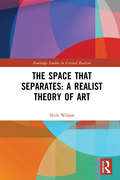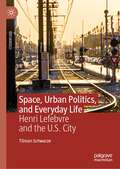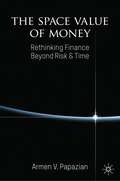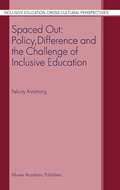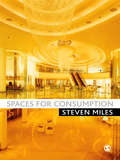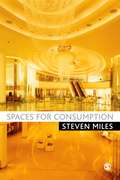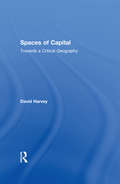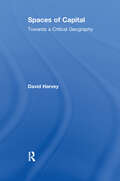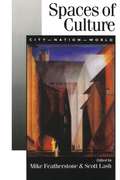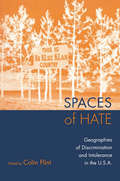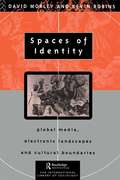- Table View
- List View
The Space of Opinion: Media Intellectuals and the Public Sphere
by Ronald N. Jacobs Eleanor TownsleyWhile the newspaper op-ed page, the Sunday morning political talk shows on television, and the evening cable-news television lineup have an obvious and growing influence in American politics and political communication, social scientists and media scholars tend to be broadly critical of the rise of organized punditry during the 20th century without ever providing a close empirical analysis. What is the nature of the contemporary space of opinion? How has it developed historically? What kinds of people speak in this space? What styles of writing and speech do they use? What types of authority and expertise do they draw on? And what impact do their commentaries have on public debate? To describe and analyze this complex space of news media, Ronald Jacobs and Eleanor Townsley rely on enormous samples of opinion collected from newspapers and television shows during the first years of the last two Presidential administrations. They also employ biographical data on authors of opinion to connect specific argument styles to specific types of authors, and examine the distribution of authors and argument types across different formats. The result is a close mapping that reveals a massive expansion and differentiation of the opinion space. It tells a complex story of shifting intersections between journalism, politics, the academy, and the new sector of think tanks. It also reveals a proliferation of genres and forms of opinion; not only have the people who speak within the space of opinion become more diverse over time, but the formats of opinion-claims to authority, styles of speech, and modes of addressing publics-have also become more varied. Though Jacobs and Townsley find many changes, they also find continuities. Despite public anxieties, the project of objective journalism is alive and well, thriving in the older, more traditional formats, and if anything, the proliferation of newer formats has resulted in an intensified commitment (by some) to core journalistic values as clear points of difference that offer competing logics of distinction and professional justification. But the current moment does represent a real challenge as more and different shows compete to narrate politics in the most compelling, authoritative, and influential manner. By providing the first systematic study of media opinion and news commentary, The Space of Opinion will fill an important gap on research about media, politics, and the civil society and will attract readers in a number of disciplines, including sociology, communication, media studies, and political science.
The Space of Opinion: Media Intellectuals and the Public Sphere
by Ronald N. Jacobs Eleanor TownsleyWhile the newspaper op-ed page, the Sunday morning political talk shows on television, and the evening cable-news television lineup have an obvious and growing influence in American politics and political communication, social scientists and media scholars tend to be broadly critical of the rise of organized punditry during the 20th century without ever providing a close empirical analysis. What is the nature of the contemporary space of opinion? How has it developed historically? What kinds of people speak in this space? What styles of writing and speech do they use? What types of authority and expertise do they draw on? And what impact do their commentaries have on public debate? To describe and analyze this complex space of news media, Ronald Jacobs and Eleanor Townsley rely on enormous samples of opinion collected from newspapers and television shows during the first years of the last two Presidential administrations. They also employ biographical data on authors of opinion to connect specific argument styles to specific types of authors, and examine the distribution of authors and argument types across different formats. The result is a close mapping that reveals a massive expansion and differentiation of the opinion space. It tells a complex story of shifting intersections between journalism, politics, the academy, and the new sector of think tanks. It also reveals a proliferation of genres and forms of opinion; not only have the people who speak within the space of opinion become more diverse over time, but the formats of opinion-claims to authority, styles of speech, and modes of addressing publics-have also become more varied. Though Jacobs and Townsley find many changes, they also find continuities. Despite public anxieties, the project of objective journalism is alive and well, thriving in the older, more traditional formats, and if anything, the proliferation of newer formats has resulted in an intensified commitment (by some) to core journalistic values as clear points of difference that offer competing logics of distinction and professional justification. But the current moment does represent a real challenge as more and different shows compete to narrate politics in the most compelling, authoritative, and influential manner. By providing the first systematic study of media opinion and news commentary, The Space of Opinion will fill an important gap on research about media, politics, and the civil society and will attract readers in a number of disciplines, including sociology, communication, media studies, and political science.
Space on Earth: Saving Our World By Seeking Others (Macmillan Science)
by C. CockellSir Arthur Clarke Award Winner Many environmentalists think going into space detracts from solving problems on Earth. Most space explorers feel environmentalism hampers their exploration of space. Leading astro-biologist Prof. Cockell argues that environmentalism and space exploration have one and the same objective, to ensure humanity has a home.
Space, Place and Global Digital Work (Dynamics of Virtual Work)
by Jörg FleckerThis edited volume seeks to enhance our understanding of the concepts of space and place in the study of digital work. It argues that while digital work is often presented as 'placeless', work always takes place somewhere with a certain degree of local embeddedness. Contributors to this collection address restructuring processes that bring about delocalised digital work and point out limitations to dislocation inherent in the work itself, and the social relations or the physical artefacts involved. Exploring the dynamics of global value chains and shifts in the international division of labour, this book explores the impact these have on employment and working conditions, workers' agency in shaping and coping with changes in work, and the new competencies needed in virtual organisational environments. Combining different disciplinary perspectives, the volume teases out the spatial aspects of digital work at different scales ranging from team level to that of global production networks.
Space, Place, and Violence: Violence and the Embodied Geographies of Race, Sex and Gender
by James A. TynerDirect, interpersonal violence is a pervasive, yet often mundane feature of our day-to-day lives; paradoxically, violence is both ordinary and extraordinary. Violence, in other words, is often hidden in plain sight. Space, Place, and Violence seeks to uncover that which is too apparent: to critically question both violent geographies and the geographies of violence. With a focus on direct violence, this book situates violent acts within the context of broader political and structural conditions. Violence, it is argued, is both a social and spatial practice. Adopting a geographic perspective, Space, Place, and Violence provides a critical reading of how violence takes place and also produces place. Specifically, four spatial vignettes – home, school, streets, and community – are introduced, designed so that students may think critically how ‘race’, sex, gender, and class inform violent geographies and geographies of violence.
Space, Place, and Violence: Violence and the Embodied Geographies of Race, Sex and Gender
by James A. TynerDirect, interpersonal violence is a pervasive, yet often mundane feature of our day-to-day lives; paradoxically, violence is both ordinary and extraordinary. Violence, in other words, is often hidden in plain sight. Space, Place, and Violence seeks to uncover that which is too apparent: to critically question both violent geographies and the geographies of violence. With a focus on direct violence, this book situates violent acts within the context of broader political and structural conditions. Violence, it is argued, is both a social and spatial practice. Adopting a geographic perspective, Space, Place, and Violence provides a critical reading of how violence takes place and also produces place. Specifically, four spatial vignettes – home, school, streets, and community – are introduced, designed so that students may think critically how ‘race’, sex, gender, and class inform violent geographies and geographies of violence.
Space Production by Migrants in China's Urban Villages: The Case of Beijing (Habitat-International: Schriften zur internationalen Urbanistik #27)
by Shiyu YangAs China races towards modernity, its cities are experiencing an unprecedented surge in urbanisation, characterised by a relentless influx of migrants and sprawling expansion into suburban realms. Shiyu Yang draws upon Henri Lefebvre's influential theoretical framework and applies it to case studies of two urban villages in Beijing to examine how migrants shape the social production of space in these districts. With a wealth of first-hand material from the field, this study provides essential insights into the ongoing processes and social dynamics that resonate with scholars from cross-disciplinary urban studies as well as practitioners in governance and urban planning.
Space Psychology and Psychiatry (Space Technology Library #22)
by Nick Kanas Dietrich ManzeyThe first edition of this book was voted Winner of the 2004 International Academy of Astronautics Life Sciences Award. The second edition deals with psychological, psychiatric, and psychosocial issues that affect people who live and work in space. Unlike other books that focus on anecdotal reports and ground-based simulation studies, this book emphasizes the findings from psychological research conducted during actual space missions. Both authors have been active in such research.
Space Stations: International Law And Policy
by Delbert D. SmithThis book explores the international law and policy relating to space stations in terms of specific barriers to utilization and considers methods or policies designed to overcome perceived barriers. It deals with the institutional possibilities and alternatives for space station ownership.
Space Stations: International Law And Policy
by Delbert D. SmithThis book explores the international law and policy relating to space stations in terms of specific barriers to utilization and considers methods or policies designed to overcome perceived barriers. It deals with the institutional possibilities and alternatives for space station ownership.
Space Systems and Sustainability: From Asteroids and Solar Storms to Pandemics and Climate Change
by Joseph N. PeltonIn his latest book, space scientist, futurist, and educator Joseph N. Pelton explores adozen ways that Planet Earth is at “existential” risk, along with the many ways thatspace systems, data analytics, and advanced networking systems can help us copewith these global challenges.The chapters examine in a straightforward way how satellite systems and technol-ogy can drastically transform fields such as pandemic tracking and global medicalresponses, cosmic hazard monitoring, nuclear energy and waste disposal, water andland pollution, tele-education/telemedicine, and military conflict. Such examplesshow how orbiting smart systems will play an ever more vital role in our vulnerablemodern world, allowing us to monitor, track, and respond to mounting problems ofthe 21st century.Dr. Pelton takes a broad view, probing the social, economic, and regulatory factorsthat are crucial to creating a more sustainable “Spaceship Earth.” This book is a callto action, promoting more organized international collaboration and investment in space technologies that can enable global change.
The Space that Separates: A Critical Realist Aesthetics (Routledge Studies in Critical Realism)
by Nick WilsonThe Space that Separates: A Realist Theory of Art radically challenges our assumptions about what art is, what art does, who is doing it, and why it matters. Rejecting the modernist and market-driven misconception that art is only what artists do, Wilson instead presents a realist case for living artfully. Art is defined as the skilled practice of giving shareable form to our experiences of being-in-relation with the real; that is to say, the causally generative domain of the world that extends beyond our direct observation, comprising relations, structures, mechanisms, possibilities, powers, processes, systems, forces, values, ways of being. In communicating such aesthetic experience we behold life’s betweenness – "the space that separates", so coming to know ourselves as connected. Providing the first dedicated and comprehensive account of art and aesthetics from a critical realist perspective – Aesthetic Critical Realism (ACR), Wilson argues for a profound paradigm shift in how we understand and care for culture in terms of our system(s) of value recognition. Fortunately, we have just the right tool to help us achieve this transformation – and it’s called art. Offering novel explanatory accounts of art, aesthetic experience, value, play, culture, creativity, artistic truth and beauty, this book will appeal to a wide audience of students and scholars of art, aesthetics, human development, philosophy and critical realism, as well as cultural practitioners and policy-makers.
The Space that Separates: A Critical Realist Aesthetics (Routledge Studies in Critical Realism)
by Nick WilsonThe Space that Separates: A Realist Theory of Art radically challenges our assumptions about what art is, what art does, who is doing it, and why it matters. Rejecting the modernist and market-driven misconception that art is only what artists do, Wilson instead presents a realist case for living artfully. Art is defined as the skilled practice of giving shareable form to our experiences of being-in-relation with the real; that is to say, the causally generative domain of the world that extends beyond our direct observation, comprising relations, structures, mechanisms, possibilities, powers, processes, systems, forces, values, ways of being. In communicating such aesthetic experience we behold life’s betweenness – "the space that separates", so coming to know ourselves as connected. Providing the first dedicated and comprehensive account of art and aesthetics from a critical realist perspective – Aesthetic Critical Realism (ACR), Wilson argues for a profound paradigm shift in how we understand and care for culture in terms of our system(s) of value recognition. Fortunately, we have just the right tool to help us achieve this transformation – and it’s called art. Offering novel explanatory accounts of art, aesthetic experience, value, play, culture, creativity, artistic truth and beauty, this book will appeal to a wide audience of students and scholars of art, aesthetics, human development, philosophy and critical realism, as well as cultural practitioners and policy-makers.
Space, Urban Politics, and Everyday Life: Henri Lefebvre and the U.S. City
by Tilman SchwarzeThis Book develops a novel and innovative methodological framework for operationalising Henri Lefebvre’s work for empirical research on the U.S. city. Building on ethnographic research on Chicago’s South Side, Tilman Schwarze explores the current situation of urbanisation and urban life in the U.S. city through a critical reading and application of Lefebvre’s writings on space, everyday life, the urban, the state, and difference. Focusing on territorial stigmatisation, public housing transformation, and urban redevelopment, this book makes an important contribution to critical urban scholarship, foregrounding the relevance and applicability of Henri Lefebvre’s work for geographical and sociological research on urban politics and everyday life.
The Space Value of Money: Rethinking Finance Beyond Risk & Time
by Armen V. PapazianThe Space Value of Money introduces a fresh and innovative perspective on sustainability and finance. It expands our financial value framework, heretofore built around risk and time, by factoring in space, as an analytical dimension and our physical context. The proposed principle and metrics entrench our responsibility for space impact into our value equations, making finance inherently sustainable and acting as a theoretical bridge between core finance theory and the growing field of sustainable finance or ESG integration. The book offers a novel approach to value design, measurement, and creation, discussing the theoretical, mathematical, institutional, technological and data elements of the transformation.The Space Value of Money principle and metrics offer us the opportunity to adjust our financial value framework and transform human productivity in line with our sustainability targets. They also enable the design and engineering of the financial instruments that can help us address our evolutionary challenges/investment, like the transition to Net Zero.“Every once in a while, a book comes along that makes a fundamental contribution that is both profound and practical. A book that every member of the National Space Council, including the NASA Administrator and the Space Force chief of space operations should read. The Space Value of Money will be of interest to ESG and impact investors, government regulators, financial theorists, and outer space enthusiasts.” —Lt Col Peter Garretson, Senior Fellow in Defense Studies at the American Foreign Policy Council“No doubt, the pressing environmental challenges we face make the concept of the space impact of investments even more compelling.” —Dr. Pascal Blanqué, Chairman of Amundi Institute, Former Group CIO of Amundi Asset Management“The Space Value of Money brings much needed conceptual rigour, whilst further advocating the case for a new paradigm shift in financial valuation. This work gives us the lasting frameworks that aggregate impact across all spatial dimensions. Dr. Papazian culminates over ten years of research in this rich book, providing the springboard for further innovation and system implementation in this area.” —Domenico Del Re, Director, Sustainability and Climate Change, PwC“Enthralling and captivating. Papazian offers a clear, thorough, and comprehensive discussion. The Space Value of Money gives us an opportunity to reframe our thinking and to explore what is possible. A great read!” —Daud Vicary, Founding Trustee of the Responsible Finance and Investment Foundation“Armen has developed a novel way to create financial models that are better suited to dealing with the many parameters required if we are to properly consider environmental factors and sustainability in economics and finance. I have found this engaging and look forward to seeing its future use.” —Dr. Keith Carne, First Bursar, King’s College, Cambridge University
Spaced Out: Policy, Difference and the Challenge of Inclusive Education (Inclusive Education: Cross Cultural Perspectives #1)
by F. ArmstrongThis work contributes to teachers’ and academic researchers’ understanding of the varied and complex ways inclusion and exclusion can be understood. It provides a lucid, coherent analysis into the nature of categorization, labeling and discursive practices within official discourse and procedures as well as the positional relationships between space, place and identities in relation to the experience of marginalized people including disabled pupils and young people.
Spaces for Consumption
by Steven MilesIn Spaces for Consumption Steven Miles develops a penetrating critique of a key shift characterising the contemporary city. Theoretically informed, the other strength of the volume lies in the wealth of examples that are drawn upon to show how cities are becoming spaces for consumption, which has itself rapidly become a global phenomenon." - Ronan Paddison, University of Glasgow "This is a great book. Powerfully written and lucid, it provides a thorough introduction to concepts of consumption as they relate to the spaces of cities. The spaces themselves - the airports, the shopping malls, the museums and cultural quarters - are analysed in marvellous detail, and with a keen sense of historical precedent. And, refreshingly, Miles doesn't simply dismiss cultures of consumption out of hand, but shows how as consumers we are complicit in, and help define those cultures. His book makes a major contribution to our understanding of contemporary cities, but is accessible enough to appeal to any reader with an interest in this important area." - Richard Williams, Edinburgh University Spaces for Consumption offers an in-depth and sophisticated analysis of the processes that underpin the commodification of the city and explains the physical manifestation of consumerism as a way of life. Engaging directly with the social, economic and cultural processes that have resulted in our cities being defined through consumption this vibrant book clearly demonstrates the ways in which consumption has come to play a key role in the re-invention of the post-industrial city The book provides a critical understanding of how consumption redefines the consumers' relationship to place using empirical examples and case studies to bring the issues to life. It discusses many of the key spaces and arenas in which this redefinition occurs including: shopping themed space mega-events architecture Developing the notion of 'contrived communality' Steven Miles outlines the ways in which consumption, alongside the emergence of an increasingly individualized society, constructs a new kind of relationship with the public realm. Clear, sophisticated and dynamic this book will be essential reading for students and researchers alike in sociology, human geography, architecture, planning, marketing, leisure and tourism, cultural studies and urban studies.
Spaces for Consumption (PDF)
by Steven MilesIn Spaces for Consumption Steven Miles develops a penetrating critique of a key shift characterising the contemporary city. Theoretically informed, the other strength of the volume lies in the wealth of examples that are drawn upon to show how cities are becoming spaces for consumption, which has itself rapidly become a global phenomenon. " - Ronan Paddison, University of Glasgow "This is a great book. Powerfully written and lucid, it provides a thorough introduction to concepts of consumption as they relate to the spaces of cities. The spaces themselves - the airports, the shopping malls, the museums and cultural quarters - are analysed in marvellous detail, and with a keen sense of historical precedent. And, refreshingly, Miles doesn't simply dismiss cultures of consumption out of hand, but shows how as consumers we are complicit in, and help define those cultures. His book makes a major contribution to our understanding of contemporary cities, but is accessible enough to appeal to any reader with an interest in this important area. " - Richard Williams, Edinburgh University Spaces for Consumption offers an in-depth and sophisticated analysis of the processes that underpin the commodification of the city and explains the physical manifestation of consumerism as a way of life. Engaging directly with the social, economic and cultural processes that have resulted in our cities being defined through consumption this vibrant book clearly demonstrates the ways in which consumption has come to play a key role in the re-invention of the post-industrial city The book provides a critical understanding of how consumption redefines the consumers' relationship to place using empirical examples and case studies to bring the issues to life. It discusses many of the key spaces and arenas in which this redefinition occurs including: shopping themed space mega-events architecture Developing the notion of 'contrived communality' Steven Miles outlines the ways in which consumption, alongside the emergence of an increasingly individualized society, constructs a new kind of relationship with the public realm. Clear, sophisticated and dynamic this book will be essential reading for students and researchers alike in sociology, human geography, architecture, planning, marketing, leisure and tourism, cultural studies and urban studies.
Spaces of Capital: Towards a Critical Geography
by David HarveyDavid Harvey is the most influential geographer of our era, possessing a reputation that extends across the social sciences and humanities. Spaces of Capital, a collection of seminal articles and new essays spanning three decades, demonstrates why his work has had-and continues to have-such a major impact. The book gathers together some of Harvey's
Spaces of Capital: Towards a Critical Geography
by David HarveyDavid Harvey is the most influential geographer of our era, possessing a reputation that extends across the social sciences and humanities. Spaces of Capital, a collection of seminal articles and new essays spanning three decades, demonstrates why his work has had-and continues to have-such a major impact. The book gathers together some of Harvey's
Spaces of Culture: City, Nation, World (PDF)
by Mike Featherstone Scott M LashIn Spaces of Culture an international group of scholars examines the implications of questions such as: What is culture? What is the relationship between social structure and culture in a globalized and networked world? Do critical perspectives still apply, or does the speed and complexity of cultural production demand new forms of analysis? They explore the key themes in social theory: the nation state; the city; modernity and reflexivity; post-Fordism and the spatial logic of the informational city. The contributors go on to analyze the public sphere, questioning the reductive representation of technology as a form of instrumentality, and demonstrating how new technologies can offer new spaces of culture. This analysis of public space is essential to an understanding of issues like global citizenship and multicultural human rights.
Spaces of Hate: Geographies of Discrimination and Intolerance in the U.S.A.
by Colin FlintFirst published in 2004. Routledge is an imprint of Taylor & Francis, an informa company.
Spaces of Hate: Geographies of Discrimination and Intolerance in the U.S.A.
by Colin FlintFirst published in 2004. Routledge is an imprint of Taylor & Francis, an informa company.
Spaces of Identity: Global Media, Electronic Landscapes and Cultural Boundaries (International Library of Sociology)
by David Morley Kevin RobinsWe are living through a time when old identities - nation, culture and gender are melting down. Spaces of Identity examines the ways in which collective cultural identities are being reshaped under conditions of a post-modern geography and a communications environment of cable and satellite broadcasting. To address current problems of identity, the authors look at contemporary politics between Europe and its most significant others: America; Islam and the Orient. They show that it's against these places that Europe's own identity has been and is now being defined. A stimulating account of the complex and contradictory nature of contemporary cultural identities.
Spaces of Identity: Global Media, Electronic Landscapes and Cultural Boundaries (International Library of Sociology)
by David Morley Kevin RobinsWe are living through a time when old identities - nation, culture and gender are melting down. Spaces of Identity examines the ways in which collective cultural identities are being reshaped under conditions of a post-modern geography and a communications environment of cable and satellite broadcasting. To address current problems of identity, the authors look at contemporary politics between Europe and its most significant others: America; Islam and the Orient. They show that it's against these places that Europe's own identity has been and is now being defined. A stimulating account of the complex and contradictory nature of contemporary cultural identities.
